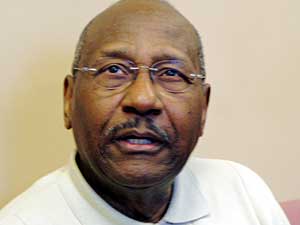|
Audio
Photos
Your Voice
|
Minnesotans reflect on impact of Brown decision
May 16, 2004
 |
| Art Cunningham of Minneapolis remembers his school years, attending segregated schools in Florida. "We didn't think of it as segregation. That's just the way it was," he says. (MPR Photo/Tim Pugmire) |
Minneapolis, Minn. — Minneapolis resident Art Cunningham graduated in 1947 from a segregated public high school in Florida. It was the "separate but equal" kind of education the Brown decision would later outlaw. Cunningham says he and his black classmates were always separated from white students. Equality was another matter.
"We used the textbooks that the white kids had used. So, many times the books we used had the leaves torn out and the backs were off," Cunningham said. "And the same thing was true about athletic equipment. After the white kids had used them up, then of course they came to us. As we walked to school, the white kids rode by us waving on the bus riding to school. We didn't think of it as segregation. That's just the way it was."
 | |||
Donald Marsh, a retired Minneapolis physician, was one of the few African-American students attending public school in Fort Madison, Iowa, in the early 1950s. He graduated in 1954, went on to college and then finished medical school at the University of Iowa. Marsh says his family moved to Iowa from Missouri to avoid segregated schools.
"In Pike County, Missouri, there was only one black high school," Marsh said. "That was in Louisiana, Missouri. And everybody had to travel to that, which in some cases was a long way away. And it was very inferior. So, a lot of my family moved to Iowa because of the educational system in Iowa."
School equality wasn't a pressing issue in Minnesota 50 years ago. Bill Green, a history professor at Augsburg College in Minneapolis, says the state Legislature passed a law in 1869 that denied public funding to any school that segregated based on race. There were a few black-only schools operating then in St. Paul. Green says state officials in 1954 viewed the Brown decision as a southern issue.
"The segregation label did not seem to apply in Minnesota like it would in other parts of the country," Green said. "And for that reason, I think the opinion-makers of Minnesota felt somehow superior, felt that their policies were vindicated, we're not like those people in the South."
 | |||
Still, there were only certain areas where black Minnesotans could find a job or a place to live in the 1950s. Schools reflected their neighborhoods. Green says 30 percent African-American enrollment was enough to be tagged as a "black school." But many schools in Minneapolis and St. Paul remained all white.
The Minneapolis school district hired Bertha Smith in 1957, three years after the Brown decision. She was one of the district's first African-American teachers. Smith says her special education classroom soon became a dumping ground for black students.
"During that time, they weren't diagnosed like they are now," Smith said. "So, because I'm of the color I am, they put all the bad kids in my class. All the ones that were behavior problems. They weren't retarded, they weren't half blind, they weren't nearsighted. They were behavior problems."
The number of black students in Minneapolis and St. Paul grew rapidly in the 1950s and 1960s. When Viki Ellis graduated from Washburn High School in 1970, half the students were black. She says it was still an era of low expectations.
"I didn't start feeling the separatism until I got to high school, when it was really time to start sending people down that college path," Ellis said. "And I was told, 'What are you interested in that for, you won't be going to college.' And I told them, 'Yes I will.'"
 | |||
In 1972, a federal judge ordered the desegregation of Minneapolis schools. The district began busing students to achieve racial balancing. By the 1990s, those imbalances had returned, fueled by white flight, continued housing segregation and a growing preference for neighborhood schools. Low test scores and graduation rates raised new questions about educational inequity.
The settlement of an NAACP lawsuit against the state created a program to allow low-income children of color in Minneapolis to attend suburban schools.
Today, Viki Ellis works as a special education assistant at a Minneapolis elementary school, where students of color make up 94 percent of the enrollment. District-wide, it's 74 percent. She says she's not surprised by the reversal.
"There are some people who truly believe, that when we look at it now, it possibly would have been better to keep African-American children segregated and being taught by African-Americans," Ellis said.
Ellis says she thinks the Brown decision improved her opportunities in the public schools, as well as her son's. But she says it might take another 50 years to fully judge its impact.
|
News Headlines
|
Related Subjects
|
